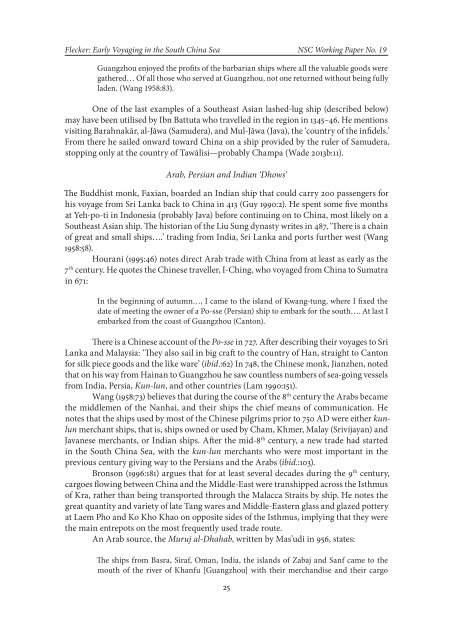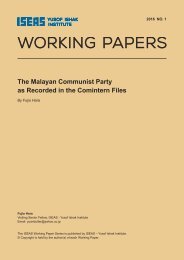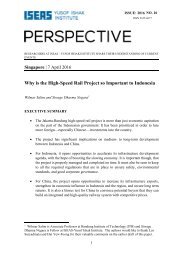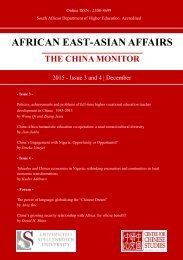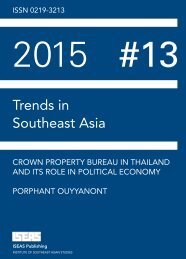NO.19
nscwps19_early_voyaging_south_china_sea_implications_territorial_claims
nscwps19_early_voyaging_south_china_sea_implications_territorial_claims
Create successful ePaper yourself
Turn your PDF publications into a flip-book with our unique Google optimized e-Paper software.
Flecker: Early Voyaging in the South China Sea NSC Working Paper No. 19Guangzhou enjoyed the profits of the barbarian ships where all the valuable goods weregathered… Of all those who served at Guangzhou, not one returned without being fullyladen. (Wang 1958:83).One of the last examples of a Southeast Asian lashed-lug ship (described below)may have been utilised by Ibn Battuta who travelled in the region in 1345–46. He mentionsvisiting Barahnakār, al-Jāwa (Samudera), and Mul-Jāwa (Java), the ‘country of the infidels.’From there he sailed onward toward China on a ship provided by the ruler of Samudera,stopping only at the country of Tawālisi—probably Champa (Wade 2013b:11).Arab, Persian and Indian ‘Dhows’The Buddhist monk, Faxian, boarded an Indian ship that could carry 200 passengers forhis voyage from Sri Lanka back to China in 413 (Guy 1990:2). He spent some five monthsat Yeh-po-ti in Indonesia (probably Java) before continuing on to China, most likely on aSoutheast Asian ship. The historian of the Liu Sung dynasty writes in 487, ‘There is a chainof great and small ships….’ trading from India, Sri Lanka and ports further west (Wang1958:58).Hourani (1995:46) notes direct Arab trade with China from at least as early as the7 th century. He quotes the Chinese traveller, I-Ching, who voyaged from China to Sumatrain 671:In the beginning of autumn…, I came to the island of Kwang-tung, where I fixed thedate of meeting the owner of a Po-sse (Persian) ship to embark for the south…. At last Iembarked from the coast of Guangzhou (Canton).There is a Chinese account of the Po-sse in 727. After describing their voyages to SriLanka and Malaysia: ‘They also sail in big craft to the country of Han, straight to Cantonfor silk piece goods and the like ware’ (ibid.:62) In 748, the Chinese monk, Jianzhen, notedthat on his way from Hainan to Guangzhou he saw countless numbers of sea-going vesselsfrom India, Persia, Kun-lun, and other countries (Lam 1990:151).Wang (1958:73) believes that during the course of the 8 th century the Arabs becamethe middlemen of the Nanhai, and their ships the chief means of communication. Henotes that the ships used by most of the Chinese pilgrims prior to 750 AD were either kunlunmerchant ships, that is, ships owned or used by Cham, Khmer, Malay (Srivijayan) andJavanese merchants, or Indian ships. After the mid-8 th century, a new trade had startedin the South China Sea, with the kun-lun merchants who were most important in theprevious century giving way to the Persians and the Arabs (ibid.:103).Bronson (1996:181) argues that for at least several decades during the 9 th century,cargoes flowing between China and the Middle-East were transhipped across the Isthmusof Kra, rather than being transported through the Malacca Straits by ship. He notes thegreat quantity and variety of late Tang wares and Middle-Eastern glass and glazed potteryat Laem Pho and Ko Kho Khao on opposite sides of the Isthmus, implying that they werethe main entrepots on the most frequently used trade route.An Arab source, the Muruj al-Dhahab, written by Mas’udi in 956, states:The ships from Basra, Siraf, Oman, India, the islands of Zabaj and Sanf came to themouth of the river of Khanfu [Guangzhou] with their merchandise and their cargo25


